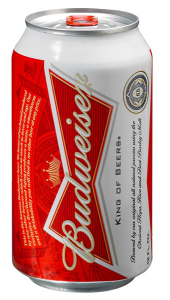Everyone’s favorite beloved high-quality American brewer, Anheuser-Busch InBev S.A., a société anonyme legally organized under the laws of Belgium, recently tried to protect an unusual bit of intellectual property: the sound of a Budweiser can opening.
 “Wait, doesn’t that sound like any kind of can opening? How can that be a trademark?” If you’re asking these questions, congratulations, you’re a reasonable human being.
“Wait, doesn’t that sound like any kind of can opening? How can that be a trademark?” If you’re asking these questions, congratulations, you’re a reasonable human being.
So can A-B protect that sound as a trademark?
When we talk about trademarks, we’re most often talking about words and logos. But, as my regular readers know, anything that uniquely identifies the source of goods or services can act as a trademark – and, in theory, can be registered with the United States Patent and Trademark Office. In the past I’ve written about color as a trademark as well as an attempt to protect the shape of a Hershey chocolate bar.
Sounds are no different – here’s my blog post on Apple’s registration of its distinctive startup sound. From that post:
Sounds can, in fact, function as trademarks, but they have to pass a fairly high bar in order to be registered…The Trademark Trial and Appeal Board (TTAB) held that a sound can be a trademark, but that the sound had to be “so inherently different or distinctive that it attaches to the subliminal mind of the listener…an association with a source or event with which it stuck.”
Getting back to the application to protect the allegedly distinct Budweiser sound, the USPTO Examining Attorney sent A-B an Office Action (essentially a rejection letter) stating:
Applicant’s proposed mark is the sound of a container of pressurized liquid being opened. Because opening a can or bottle of beer is normal in the course of operating the goods before they are consumed, the mark fails to function as a trademark.
Moreover, because virtually all beer bottles and beer cans make this same general sound when opened, regardless of the provider, applicant cannot claim sufficient exclusivity of the use of the sound in order to claim §2(f) acquired distinctiveness in the sound. To support a claim of acquired distinctiveness, an applicant must demonstrate substantially exclusive use of a mark in order to show that the purchasing public has come to view the mark as an indicator of origin…
To put it another way, in order for A-B’s sound to be registered as a trademark, the public would have to recognize that sound as being distinctly that of a Budweiser can being opened (this is called “acquired distinctiveness.”) The Office Action included links to online audio files of cans opening to prove that they all sound more or less the same.
A-B responded, in part:
[T]he Office Action mistakenly treats Applicant’s [note: Applicant is Anheuser-Busch] sound mark as one resulting from product design, as opposed to one resulting from product packaging…
Applicant’s sound mark is not the result of Applicant’s beer, but is instead the result of opening the packaging for Applicant’s beer…
Applicant’s sound mark is inherently distinctive in that it comprises the following elements:
1) a loud “clicking” noise, accompanied with hissing, caused by opening a vent in a can by pulling a tab in one direction, followed by
2) a period of silence, and then finally, a
3) a deeper “clicking” noise, caused by opening a different vent in the same can by pushing the same tab in the opposite direction.
As these elements suggest, Applicant’s mark has two distinct “clicking” noises, with a period of silence in between them, which results from opening up two different vents in the same can…
…Applicant’s can has two vents, one of which is opened by pushing (or pulling) the tab in one direction, and the other is opened by pulling (or pushing) the same tab in the opposite direction. This second vent is significant because it is what creates the differentiated, and unique, second clicking sound in Applicant’s sound mark. And, the need to change direction when moving the tab from one vent to another is what creates the pause in between the two clicks heard in Applicant’s mark.
Accordingly, Applicant submits that its sound mark is noticeably different in both tempo and pitch from the “sound bites” cited by the Examiner.
Significantly, Applicant’s sound mark has a period of silence, which the sound in the three “sound bites” do not.
Accordingly, Applicant’s is clearly distinguishable from the three sound bite referenced attached to the Office Action (which themselves are virtually indistinguishable from one another) and is inherently distinctive because it is unique in the context of beer.
One has to give A-B’s lawyers’ credit – they really tried to make something out of nothing. The USPTO wasn’t convinced. On August 19 of this year, they sent out a Final Office Action, again refusing to register the mark and stating that “the applied-for mark is not inherently distinctive because all beverage cans make a highly similar sound.” The USPTO Examining Attorney included an amusing video of himself, in his basement, opening several cans of beer (including a few craft beers, which is nice to see) and one of Coca-Cola. He then switches off the camera in order to avoid drinking on the clock (he is an employee of the federal government, after all.) Unfortunately it’s not easy to view that video unless you want to download the 125 MB .wav file (the USPTO doesn’t post their evidence videos on YouTube, unfortunately). My favorite part is near the end when he states, “Unfortunately I could not get the federal government to reimburse me for the cost of alcohol, so I had to buy these on my own.” Now that’s a dedicated public servant.
What have we learned? Sounds can act as trademarks, and can be registered as such, but not just any sound will do.

